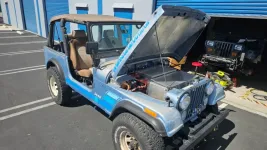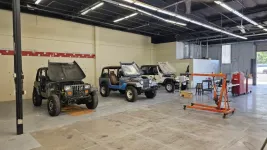CJ EV Conversion
-
Hello Guest, we are proud to now have our Wiki online that is completely compiled and written by our members. Feel free to browse our Jeep-CJ Wiki or click on any orange keyword when looking at posts in the forum.
You are using an out of date browser. It may not display this or other websites correctly.
You should upgrade or use an alternative browser.
You should upgrade or use an alternative browser.
CJ EV Conversion
- Thread starter 4x4 EVC
- Start date Start date:
- Last post Last post:
CJ EV Conversion
4x4 EVC
Jeeper
TSB8C
Old Time Jeeper
- Posts
- 1,144
- Featured
- 11
- Media
- 26
- Resources
- 1
- Solutions
- 29
- Thanks
- 619
- Location
- Cut-n-Shoot, TX
- Vehicle(s)
- 1984 CJ7, 420 HP "ZZ6 EFI" Crate engine, 700R4, D300, Dana30 front, Dana489 rear, 4.56 gears, 4" lift
What's a CJ get in terms of miles range once converted to EV? I've always been curious. And just a few other questions - if you don't mind:I convert CJs to all EV. Here's a couple pictures:
- Patrick
1. Power steering and/or brakes still an option?
2. AC an option?
3. What happens to the Transmission ? Still needed at all? Just leave in one gear? Other?
Thanks.
4x4 EVC
Jeeper
PLEASE, ask away!What's a CJ get in terms of miles range once converted to EV? I've always been curious. And just a few other questions - if you don't mind:
1. Power steering and/or brakes still an option?
2. AC an option?
3. What happens to the transmission? Still needed at all? Just leave in one gear? Other?
Thanks.
Typically, around 110 miles city, around 80 highway (the reverse of an ICE vehicle).
1. Yep, PS provided by a Volvo unit - works better than it did stock (by a lot).
2. AC is an option - if you look close, you'll see a YJ and a TJ in the shop, both have AC. We haven't done one for a CJ yet. Not hard but have to admit we haven't done that for CJs yet.
3. So, full stock Transmission - fully shiftable, stock Transfer Case , NO CLUTCH. We call it Semi-manual (semi-automatic was already taken...). For most driving, 2nd and 3rd are all you need. You don't need to shift if don't want to.
Full Regen, Single Pedal Mode.
Super fun, best Jeep I've ever owned.
- Patrick
TSB8C
Old Time Jeeper
- Posts
- 1,144
- Featured
- 11
- Media
- 26
- Resources
- 1
- Solutions
- 29
- Thanks
- 619
- Location
- Cut-n-Shoot, TX
- Vehicle(s)
- 1984 CJ7, 420 HP "ZZ6 EFI" Crate engine, 700R4, D300, Dana30 front, Dana489 rear, 4.56 gears, 4" lift
Thanks. Great info. And what's the expectation on battery life? I'm asking because I've considered getting a cheap CJ with a dead or no engine and doing an EV conversion.
CJ
Admin
- Posts
- 25,418
- Featured
- 3
- Media
- 881
- Resources
- 193
- Solutions
- 57
- Thanks
- 1,003
- Location
- Central FL
- Vehicle(s)
- '72 CJ5, 401, T18, D20, D44, D30
'82 CJ8, 258, D300, AMC20, D30
Cool idea. My question is what battery? That is a very low distance for lion. If it's lion, how do you cool them?
4x4 EVC
Jeeper
15 - 20 years with less then a 1.8% degradation (it won't go back up to 100% SOC (State of Charge), at the end it would only go up to ~97% full SOC).Thanks. Great info. And what's the expectation on battery life? I'm asking because I've considered getting a cheap CJ with a dead or no engine and doing an EV conversion.
I'm not sure I believe that despite being on this side the the EV divide. Also, Jeep. I'd feel very comfortable saying at least 15 years of full service.
BUT, who cares. With the speed of development and delivery, battery technology is both increasing in energy density (longer range for the same weight) AND price.
The Tesla Model S modules we use, they are now below half the price we paid when we started this last year!!!
All the translates to upgrades in batteries down the road if the owner see a need.
As far as DIY Jeep EV build - I personally fully encourage EVERYONE that owns a set of wrenches to do it. It's the funnest thing I've ever done and now it's my full time job.
We are aiming to have retail kits ready for sale in the next 12-18 months.
Fair warning: the battery boxes are a bitch to build. Break out the CAD (Cardboard Aided Design) and blue tape (lots and lots of blue tape).
Hope this helps!
- Patrick
4x4 EVC
Jeeper
Haha - I read that as 'Lion' not Li Ion battery ....!Cool idea. My question is what battery? That is a very low distance for lion. If it's lion, how do you cool them?
Okay, so, the deal is you can only get so many miles per gallon per ICE vehicles and you only get so many miles per kWh for EV. My Chevy Bolt, for example, gets about 3.8 miles per kWh.
Quick translation: Gas cost $x.00 gallon and if you look at your electric bill, you are charged by the kWh. In Los Angeles, where we work and live, that's about $0.22cents / kWh. So, you take $0.22cents and divide that by 3.8mi/kWh and you get $0.06 per mile.
Our EV Jeeps get about 2.5miles per kWh so, same math, you get $0.09 per mile if you change at home.
We use 7 Tesla Model S modules from a Tesla pack of 14 modules - half a Tesla's worth. Each module weighs about 55lbs. We balanced the weight with the size of the stock Jeep and it works. It's just about 80 miles shy of a stock CJ7 that gets about 189 miles on a full (18gal) tank.
I'd LOVE to get 200 miles from our builds but the trade off of better batteries or more of them, or a combination ONLY adds weigh and more then doubles the costs, almost all in the cost of the batteries.
Yes, we have cooling loops for all our system. The motors are air cooled.
If I strayed outside of your question, sorry, let me know if I at least answered it.
- Patrick
CJ
Admin
- Posts
- 25,418
- Featured
- 3
- Media
- 881
- Resources
- 193
- Solutions
- 57
- Thanks
- 1,003
- Location
- Central FL
- Vehicle(s)
- '72 CJ5, 401, T18, D20, D44, D30
'82 CJ8, 258, D300, AMC20, D30
Best answer ever!Haha - I read that as 'Lion' not Li Ion battery ....!
Okay, so, the deal is you can only get so many miles per gallon per ICE vehicles and you only get so many miles per kWh for EV. My Chevy Bolt, for example, gets about 3.8 miles per kWh.
Quick translation: Gas cost $x.00 gallon and if you look at your electric bill, you are charged by the kWh. In Los Angeles, where we work and live, that's about $0.22cents / kWh. So, you take $0.22cents and divide that by 3.8mi/kWh and you get $0.06 per mile.
Our EV Jeeps get about 2.5miles per kWh so, same math, you get $0.09 per mile if you change at home.
We use 7 Tesla Model S modules from a Tesla pack of 14 modules - half a Tesla's worth. Each module weighs about 55lbs. We balanced the weight with the size of the stock Jeep and it works. It's just about 80 miles shy of a stock CJ-7 that gets about 189 miles on a full (18gal) tank.
I'd LOVE to get 200 miles from our builds but the trade off of better batteries or more of them, or a combination ONLY adds weigh and more then doubles the costs, almost all in the cost of the batteries.
Yes, we have cooling loops for all our system. The motors are air cooled.
If I strayed outside of your question, sorry, let me know if I at least answered it.
- Patrick

CJ
Admin
- Posts
- 25,418
- Featured
- 3
- Media
- 881
- Resources
- 193
- Solutions
- 57
- Thanks
- 1,003
- Location
- Central FL
- Vehicle(s)
- '72 CJ5, 401, T18, D20, D44, D30
'82 CJ8, 258, D300, AMC20, D30
4x4 EVC
Jeeper
First, we do 1976 to 2006 only for now - CJ, YJ and TJ. No JKs.I'm betting one of your big problems is that CJs, YJs, JKs etc and such have very limited. floor real estate as well as they are very irregular.
No, that's not too bad. I made a decision early on not to encroach into the tub at all so, back battery box fits exactly where the gas tank was, bolts into the factory bolts. The rest is tucked into the engine by. Not much room left but it all fits.
My biggest problem is: I'm customer rich but cash (flow) poor.
The CJ's were about 6" narrower in the frame. But the later models are wider but shorter. In the CJs we have 3 battery boxes:
- Back Battery Box - 3 modules
- Front Battery Box - 3 modules
- Intermediate Battery Box (in the front but under the Tech box) - 1 module
In the YJ and TJs:
- Back Battery Box - 3 modules
- Front Battery Box - 4 modules
Less boxes = happiness.
Nothing in the tub - including ANY engine heat. You can drive without shoes and not burn your feet!
It's just better.
- Patrick
CJ
Admin
- Posts
- 25,418
- Featured
- 3
- Media
- 881
- Resources
- 193
- Solutions
- 57
- Thanks
- 1,003
- Location
- Central FL
- Vehicle(s)
- '72 CJ5, 401, T18, D20, D44, D30
'82 CJ8, 258, D300, AMC20, D30
4x4 EVC
Jeeper
I humbly accept your applause.Actually, if my limited understanding (sarcasm) is you have accomplished a very cool thing. You have lowered the CJs high center of gravity!
For this I applaud you.
Check your messages.
Thanks and you are correct, we did lower it in two ways - 1. We removed a lot of the weight by removing the engine - 700ish lbs concentrated in a line running down the middle of the Jeep. The Front Battery Box and Tech box are around 250lbs and layed out wide, between the fender wells, thereby both distributing the weight over the wheels and changing it's specific center of gravity configuration - all to make it harder to flip. 2. With the back battery box weighing in at just under 200lbs and tucked up exactly where the gas tank was, we've made it such that you're usually weightless back-end is now fully weighed down and distributed wide, again, contributing to reducing overall center of gravity. Like having a full tank of gas and a fat kid always riding in the back (don't even ask who's kid he is, just assume he came with the Jeep and move on...)
You absolutely feel it when you drive.
- Patrick
Belizean
Always Off-Roading Jeeper
- Posts
- 6,815
- Featured
- 1
- Media
- 20
- Solutions
- 3
- Thanks
- 673
- Location
- New Orleans area
- Vehicle(s)
- 84 CJ7 4 banger-owned since new in 1984 bought off truck at dealership - rebuilding 258, T176 with Sniper EFI D300 4:1 Lomax gears Twin Sticked 1 piece axels with locker
I definitely like the idea of riding with no shoes and cool feet. 

CJ
Admin
- Posts
- 25,418
- Featured
- 3
- Media
- 881
- Resources
- 193
- Solutions
- 57
- Thanks
- 1,003
- Location
- Central FL
- Vehicle(s)
- '72 CJ5, 401, T18, D20, D44, D30
'82 CJ8, 258, D300, AMC20, D30
My 72 has very rare in frame headers so the floor boards get terribly hot. I can't believe my shoes never melted.I definitely like the idea of riding with no shoes and cool feet.
Belizean
Always Off-Roading Jeeper
- Posts
- 6,815
- Featured
- 1
- Media
- 20
- Solutions
- 3
- Thanks
- 673
- Location
- New Orleans area
- Vehicle(s)
- 84 CJ7 4 banger-owned since new in 1984 bought off truck at dealership - rebuilding 258, T176 with Sniper EFI D300 4:1 Lomax gears Twin Sticked 1 piece axels with locker
On a hot summer day a 4 cylinder and 6 cylinder get, and produce plenty of hot. Works out better in the winter. Just cruzing around you don’t notice at all. Sit in traffic and you realize your seat is sitting on a skillet. Mine came with a heat shield above the muffler new, but I had to get a big chunk of the exhaust system replaced and didn’t realize right away that they left that off and weren’t going to do anything about it.
- Posts
- 1,239
- Featured
- 2
- Media
- 9
- Solutions
- 3
- Thanks
- 119
- Location
- Pittsboro, NC
- Vehicle(s)
- 1981 CJ5/258 4.2L I6, Tremec T-176 4-speed, Dana 300, Power Steering, Howell Throttle Body Injection System, Warn Locking Hubs, Warn Rock Crawler front/rear bumper with Tire Swing Carrier, Full Roll Cage, Pro Comp ES9000 shocks
At $5+ a gallon and SMOG inspection, I totally understand why California CJ owners would convert to EV. It's either that or moving to Arizona.  When I was living in Carlsbad, I was considering converting my Landrover Disco to CNG.
When I was living in Carlsbad, I was considering converting my Landrover Disco to CNG.
Last edited:
Jeep-CJ Donation Drive
Help support Jeep-CJ.com by making a contribution.
Help support Jeep-CJ.com by making a contribution.
Goal
$200.00
Earned
$0.00
This donation drive ends in
0 hours,
0 minutes,
0 seconds
0.0%



